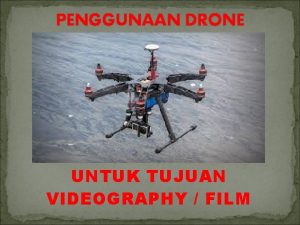SemiAutonomous UAV for Surveillance and Emergency Response SAUSER

- Slides: 1

Semi-Autonomous UAV for Surveillance and Emergency Response (SAUSER) Department of Industrial and System Engineering By: Arshdeep Sandhu, Ryan Foster, and Kenneth Jones Advisor: Dr. Adeel Khalid CALCULATIONS ABSTRACT The SAUSER drone system is a surveillance system that provide aerial footage of traffic accidents and other emergency situations. The drone system uses a docking station that can be mounted on traffic lights to allow for rapid deployment. The mounting docks also function as wireless charging stations. The SAUSER system can be deployed on large number for emergency response and surveillance of cities. PROBLEM STATEMENT To design a drone surveillance system optimized for first response in emergency traffic situations. Figure 1 – The flow trajectories of the rotor analysis Figure 2 – The pressure contours of the body’s CFD analysis at full power. DESIGN SPECIFICATIONS Figure 5 – The parametric values obtained from BEMT analysis (single rotor). • Max take-off weight of 13 lbf. Present Value Analysis • Total Thrust of 57. 764 N Total Initial Cost (per system) • Payload capacity of 2 lbf. Total Annual Cost (per system) $457, 942 Present Value (assuming 5% interest $3, 723, 907 for 10 years) • Max Service Ceiling 5000 m @MSL • Max speed of 22 m/s or 50 mph • Maximum Flight time of 34 minutes Figure 4 – Present value analysis of the SAUSER system. • Total Power consumption of 535. 16 W • Final design dimensions: Length 17 in, Height 10 in and Width 17 in. $187, 800 Figure 3 – The cycle to failure plot of the body’s fatigue analysis with 7075 -T 6 aluminum CONCLUSION Our Final Design presents a viable solution to our problem statement per our design goals. The design specifications were met, and detailed BEMT, CFD and FEA analysis shows the viability of our design. The economic analysis validates the feasibility of the SAUSER system as per budgetary requirements. We are confident that our design could be successfully brought into reality and implemented on large scale for surveillance purpose. ACKNOWLEDGEMENT We would like to thank Dr. Adeel Khalid for his guidance throughout this project.

